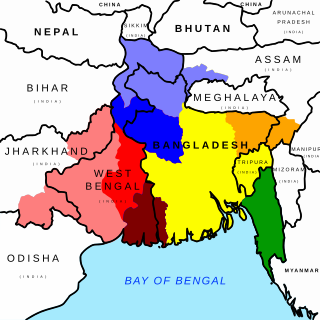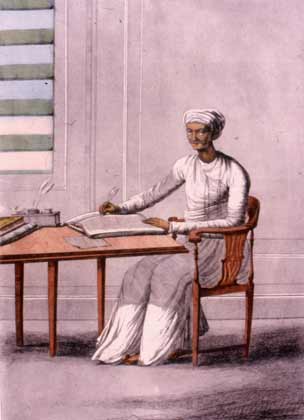
The Bhakti movement was a significant religious movement in medieval Hinduism that sought to bring religious reforms to all strata of society by adopting the method of devotion to achieve salvation. Originating in Tamilakam during 6th century CE, it gained prominence through the poems and teachings of the Vaishnava Alvars and Shaiva Nayanars before spreading northwards. It swept over east and north India from the 15th century onwards, reaching its zenith between the 15th and 17th century CE.

The Smartatradition, also called Smartism, is a movement in Hinduism that developed and expanded with the Puranas genre of literature. It reflects a synthesis of four philosophical strands, namely Uttara Mīmāṃsā, Advaita, Yoga, and theism. The Smarta tradition rejects theistic sectarianism, and is notable for the domestic worship of five shrines with five deities, all treated as equal – Ganesha, Shiva, Shakti, Vishnu and Surya. The Smarta tradition contrasted with the older Shrauta tradition, which was based on elaborate rituals and rites. There has been a considerable overlap in the ideas and practices of the Smarta tradition with other significant historic movements within Hinduism, namely Shaivism, Brahmanism, Vaishnavism, and Shaktism.
Muslim Rajputs or Musalman Rajpoots are the descendants of Rajputs in the northern regions of the Indian subcontinent who generally are followers of Islam. They converted from Hinduism to Islam from the medieval period onwards, creating various dynasties and states while retaining Hindu surnames such as Chauhan. Today, Muslim Rajputs can be found mostly in present-day Northern India and Pakistan. They are further divided into different clans.

The Ramanandi, also known as Ramavats, is one of the largest sects of Vaishnavas. Out of 52 sub-branches of Vaishnavism, divided into four Vaishnava sampradayas, 36 are held by the Ramanandi. The sect mainly emphasizes the worship of Rama, Sita, Hanuman, and the avatars of Vishnu. They consider Rama and Sita as the Supreme Absolute who are not different from each other. It is considered to have been founded by Ramananda, a 14th-century Vaishnava saint.
Panchal is a Master Craftsman caste of India. Panchal is a collective term for class of engineers, architects, priests, sculptors and temple builders. They belong to the Vishwakarma sect

Sri Vaishnavism is a denomination within the Vaishnavism tradition of Hinduism, predominantly practiced in South India. The name refers to goddess Lakshmi, as well as a prefix that means "sacred, revered", and the god Vishnu, who are together revered in this tradition.

Hinduism is the largest religious tradition in the Indian state of West Bengal with approximately 70.54% of the population identifying themselves as Hindus. The Hindus in West Bengal mostly belong to the Shakta, minority to Vaishnavite and a small community belong to Shaivite and other denominations. The vast majority of Hindus in West Bengal are Bengali Hindus numbering around 55 million and comprising 60.2% of the state population of 91.35 million (2011) but a notable section of non-Bengali Hindus also exist, particularly among Marwaris, Biharis, Odias, Gurkhas, Sindhis, Gujaratis and various tribal communities such as Koch, Santals, Munda, Mech people and particularly Adivadis numbering around 9.4 million comprising rest 10.3% of the state population.

Patachitra or Pattachitra is a general term for traditional, cloth-based scroll painting, based in the eastern Indian states of Odisha, West Bengal and parts of Bangladesh. Patachitra artform is known for its intricate details as well as mythological narratives and folktales inscribed in it. Pattachitra is one of the ancient artworks of Odisha, originally created for ritual use and as souvenirs for pilgrims to Puri, as well as other temples in Odisha. Patachitras are a component of an ancient Bengali narrative art, originally serving as a visual device during the performance of a song.

Bengali Hindus are an ethnoreligious population who make up the majority in the Indian states of West Bengal, Tripura, Andaman and Nicobar Islands, Jharkhand, and Assam's Barak Valley region. In Bangladesh, they form the largest minority. They are adherents of Hinduism and are native to the Bengal region in the eastern part of the Indian subcontinent. Comprising about one-third of the global Bengali population, they are the largest ethnic group among Hindus. Bengali Hindus speak Bengali, which belongs to the Indo-Aryan language family and adhere to Shaktism or Vaishnavism of their native religion Hinduism with some regional deities. There are significant numbers of Bengali-speaking Hindus in different Indian states.
Satani is a community that renders temple services in the states of Andhra Pradesh, Karnataka, Tamil Nadu and Telangana in India. Traditionally, they have rendered a variety of services as supervisors and purohits of minor temples, guardians of temple properties, heralds, singers and torch-bearers at festivals, bodyguards of Jiyars, and providers of umbrellas, flower garlands, and namam clay. They have claimed Brahmin status, although this has been contested by Brahmins as they do not wear the sacred thread and they do not study or chant/recite Sanskrit Vedas or Gayatri Mantra, but they study and recite only Naalayira Divya Prabandham written by Alvars. They are currently included in the Other Backward Classes (OBC) list by the central and state governments.
The Kartabhaja, also known as the Kartabhaja Sampradaya, literally, the Worshippers of the Master, is a religious community of West Bengal in eastern India, which came into prominence in the mid 18th century. It had a significant following in the late 18th century and early 19th century, but its following declined considerably in the early 20th century.

The Matua Mahasangha is a Hindu reform movement that originated around 1860 AD in modern-day Bangladesh. Today, it has a considerable number of adherents both in Bangladesh and in West Bengal, India.
Baidya or Vaidya is a Bengali Hindu community located in the Bengal region of Indian subcontinent. A caste (jāti) of Ayurvedic physicians, the Baidyas have long had pre-eminence in society alongside Brahmins and Kayasthas. In the colonial era, the Bhadraloks were drawn primarily, but not exclusively, from these three upper castes, who continue to maintain a collective hegemony in West Bengal.
The Vishwakarma community are a social group of India, sometimes described as a caste. They claim themselves to be Brahmin or of high-status in the caste hierarchy, although these claims are not generally accepted outside the community. The community comprises five subgroups—carpenters, blacksmiths, bronze smiths, goldsmiths and stonemasons— claim to be descendants of Vishvakarma, the builder and architect of heavenly realm, a Hindu deity.

Bengali Kayastha is a Bengali Hindu caste originated from the Bengal region of Indian subcontinent, and is one of the main subgroups of the Kayastha community. The historical caste occupation of Kayasthas throughout India has been that of scribes, administrators, ministers and record-keepers; the Kayasthas in Bengal, along with Brahmins and Baidyas, are regarded among the three traditional higher castes that comprise the "upper layer of Hindu society". During the British Raj, the Bhadraloks of Bengal were drawn primarily, but not exclusively, from these three castes, who continue to maintain a collective hegemony in West Bengal.

The history of the textile arts of Bangladesh dates back to the 1st century AD. According to the archaeological excavations, Bangladesh was once famous for its artistic textile production throughout the world. Over the years, several types of textiles evolved in the country, mostly by the indigenous handloom manufacturers.
The Gurav are an occupational community comprising several castes. They are among the traditional service providers found in villages, for whom they are in a priest role, and are found in several states of India.

The Indian state West Bengal has a rich cultural heritage. Due to the reign of many different rulers in the past, arts and crafts in West Bengal underwent many changes giving an artistic diversity today in the forms of traditional handicrafts, terracotta, painting and carving, dances and music.

Bairagi Brahmin or Vaishnav Bairagi or Vaishnav Brahmin is a Hindu caste. They are Hindu priests. They are sedentary rasik Brahmin members of the Vaishnava sampradayas, especially the Ramanandi Sampradaya. According to K.S. Singh, the community uses different Surnames/Titles in different States and union territories of India, these are - Swami, Bairagi, Mahanta, Maharaj, Vaishnav, Bawa, Pandit, Purohit, Goswami, Sharma, Adhikari and Vairagi. They are Vaishnav, and wear the sacred thread. A majority of Bairagi Brahmin is found in Uttar Pradesh, Bihar, Jharkhand, West Bengal, Assam, and Odisha. Bairagi are considered as part of the 'upper castes' of Bengal.












